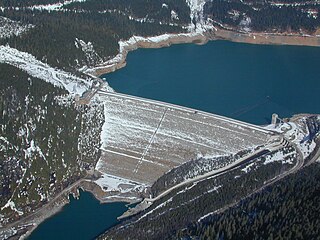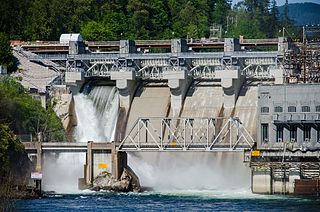The British Columbia Hydro and Power Authority, operating as BC Hydro, is a Canadian electric utility in the province of British Columbia. It is the main electricity distributor, serving more than 4 million customers in most areas, with the exception of the City of New Westminster, where the city runs its own electrical department and portions of the West Kootenay, Okanagan, the Boundary Country and Similkameen regions, where FortisBC, a subsidiary of Fortis Inc. directly provides electric service to 213,000 customers and supplies municipally owned utilities in the same area. As a provincial Crown corporation, BC Hydro reports to the BC Ministry of Energy, Mines and Low Carbon Innovation, and is regulated by the British Columbia Utilities Commission (BCUC). Its mandate is to generate, purchase, distribute and sell electricity.

Mica Dam is a hydroelectric embankment dam spanning the Columbia River 135 kilometres north of Revelstoke, British Columbia, Canada. It was built as one of three Canadian projects under the terms of the 1964 Columbia River Treaty and is operated by BC Hydro. Completed in 1973, the Mica powerhouse had an original generating capacity of 1,805 megawatts (MW). Mica Dam, named after the nearby settlement of Mica Creek and its associated stream, in turn named after the abundance of mica minerals in the area, is one of the largest earthfill dams in the world. The reservoir created by the dam is Kinbasket Lake. Water from the dam flows south directly into Revelstoke Lake, the reservoir for the Revelstoke Dam. Mica Dam is the tallest dam in Canada and second tallest in North America after the Chicoasén Dam in Mexico and it is the farthest upstream dam on the Columbia River. The dam's underground powerhouse was the second largest in the world at the time of its construction, and was the first 500 kV installation of sulphur hexafluoride (SF6) insulated switchgear in the world.

The electricity sector in Canada has played a significant role in the economic and political life of the country since the late 19th century. The sector is organized along provincial and territorial lines. In a majority of provinces, large government-owned integrated public utilities play a leading role in the generation, transmission, and distribution of electricity. Ontario and Alberta have created electricity markets in the last decade in order to increase investment and competition in this sector of the economy.

The Stave River is a tributary of the Fraser, joining it at the boundary between the municipalities of Maple Ridge and Mission, about 35 kilometres (22 mi) east of Vancouver, British Columbia, Canada, in the Central Fraser Valley region.
Finavera Wind Energy Inc. is a former Canadian wind power company, between 2007 and 2017, that owned and operated wind farms in northeastern British Columbia. Headquartered in Vancouver, the company began listing shares on TSX Venture Exchange in 2007 until it was acquired in 2017 by Solar Alliance Energy Inc TSX: SOLR. Formerly named Finavera Renewables Inc., the company develops wind farms in Canada and Ireland. The company was founded in Dublin, Ireland, in 2003. On 4 April 4, 2005, Finavera acquired a 10% stake in the wave energy technology company AquaEnergy Group, and in 2006, it acquired rest of the shares in AquaEnergy. AquaEnergy became a wholly owned subsidiary of Finavera and was renamed Finavera Renewables Ocean Energy. It developed the AquaBuOY wave energy conversion technology with plan to install the converter in Makah Bay off the coast of Newport, Oregon. However, in 2010 Finavera Renewables Ocean Energy was sold and Finavera concentrated to the wind energy.
Kanaka Bar First Nation is a First Nations government located at Kanaka Bar, British Columbia, Canada, between the towns of Boston Bar and Lytton in the Fraser Canyon region. It is a member of the Fraser Canyon Indian Administration, one of three tribal councils of the Nlaka'pamux people. Other members of the Fraser Canyon Indian Administration are the Spuzzum, Skuppah and Nicomen First Nations. Other Nlaka'pamux governments belong either to the Nicola Tribal Association or the Nlaka'pamux Nation Tribal Council.
FortisBC is a Canadian owned, British Columbia based regulated utility focused on providing safe and reliable energy, including natural gas, Renewable Natural Gas, electricity and propane. FortisBC has approximately 2,600 employees serving more than 1.2 million customers in 135 B.C. communities and 58 First Nations communities across 150 Traditional Territories.
According to the International Hydropower Association, Canada is the fourth largest producer of hydroelectricity in the world in 2021 after the United States, Brazil, and China. In 2014, Canada consumed the equivalent of 85.7 megatonnes worth of oil of hydroelectricity, 9.8% of worldwide hydroelectric consumption. Furthermore, hydroelectricity accounted for 25.7% of Canada's total energy consumption. It is the third-most consumed energy in Canada behind oil and natural gas.
Rutherford Creek is a tributary of the Green River, British Columbia, Canada, entering that river a few miles above Nairn Falls Provincial Park, near the village of Pemberton. The creek's headwaters are on the eastern side of the Pemberton Icefield, from where it flows southeast for the first half of its course, then generally east for the remainder. It is approximately 24 km (15 mi) in length. The mouth is at 50° 16' 3" N, 122° 57' 41" W.

Capital Power is an independent power generation company based in Edmonton, Alberta, Canada. Capital Power develops, acquires, owns and operates power generation facilities using a variety of energy sources. Capital Power owns approximately 6,600 megawatts of power generation capacity at 27 facilities across North America.
Veresen Inc. was a Calgary, Alberta-based energy infrastructure company with three main lines of business: pipelines, natural gas and power generation. It was a publicly-traded company on the Toronto Stock Exchange, and was known as Fort Chicago Energy Partners L.P. In 2017, it was acquired by Pembina Pipeline for $9.7 billion.

Alterra Power Corp. a subsidiary of Innergex Renewable Energy Inc., is a diversified renewable power generation company based in Vancouver, British Columbia, Canada. It was formed in 2011 through the merger of Magma Energy Corp. and Plutonic Power Corp. It develops, owns, acquires and operates hydroelectric, wind, solar energy and geothermal projects. On February 6, 2018, Innergex Renewable Energy Inc. completed the acquisition of Alterra including all its assets.

Run of River Power or ROR Power is a Canadian based energy company. Its business in the renewable energy sector, creating sustainable energy through its portfolio of run-of-river and biomass projects in British Columbia.
Synex International Inc. is a Vancouver-based company that has traded on the Toronto Stock Exchange since 1987. It is made up of two wholly owned subsidiary companies: Synex Energy Resources Ltd. and Sigma Engineering Ltd..
Innergex Renewable Energy is a developer, owner and operator of run-of-river hydroelectric facilities, wind energy, and solar farms in North America. While many of the firm's operational assets are located in its home province of Québec, it has expanded into Ontario, British Columbia, and Idaho.
Renewable Power Corp. is a privately owned company based in Gibsons, British Columbia, which was established in 2000. Marc Soprovich (President) and Peter Schober are listed as the firm’s co-owners.
Regional Power, a subsidiary of Manulife Financial, has been developing and operating independent power projects since the mid-1980s. Currently, the firm operates six hydro plants on behalf of other developers with a total generating capacity of 36 megawatts.
Independent Power Producer (IPP) projects have had a significant presence in British Columbia since the 1980s. Their relationship with BC Hydro grew from the province's need to supply growing energy demands and implementation of the 2002 Energy Strategy, which mandated that BC Hydro would purchase its energy supply from IPPs rather than generating the supply itself. There are a variety of power projects in BC, with the most popular being hydroelectricity and biomass projects. In recent years, more attention has been placed on the environmental effects of IPP projects and the social implications it has to residents living around the project development sites. Despite the decline in demand for new IPP projects, in 2016 they supplied 20,000 GWh, one-third of BC Hydro's total.